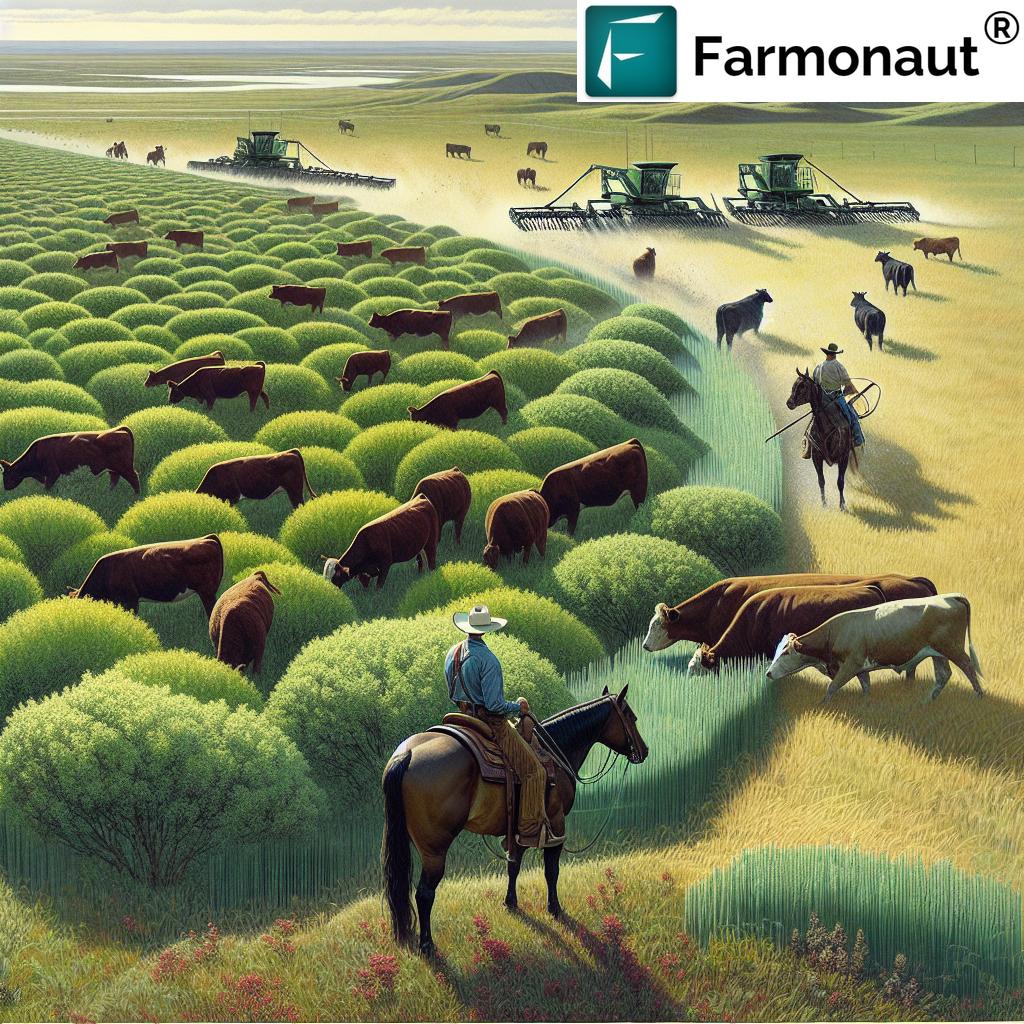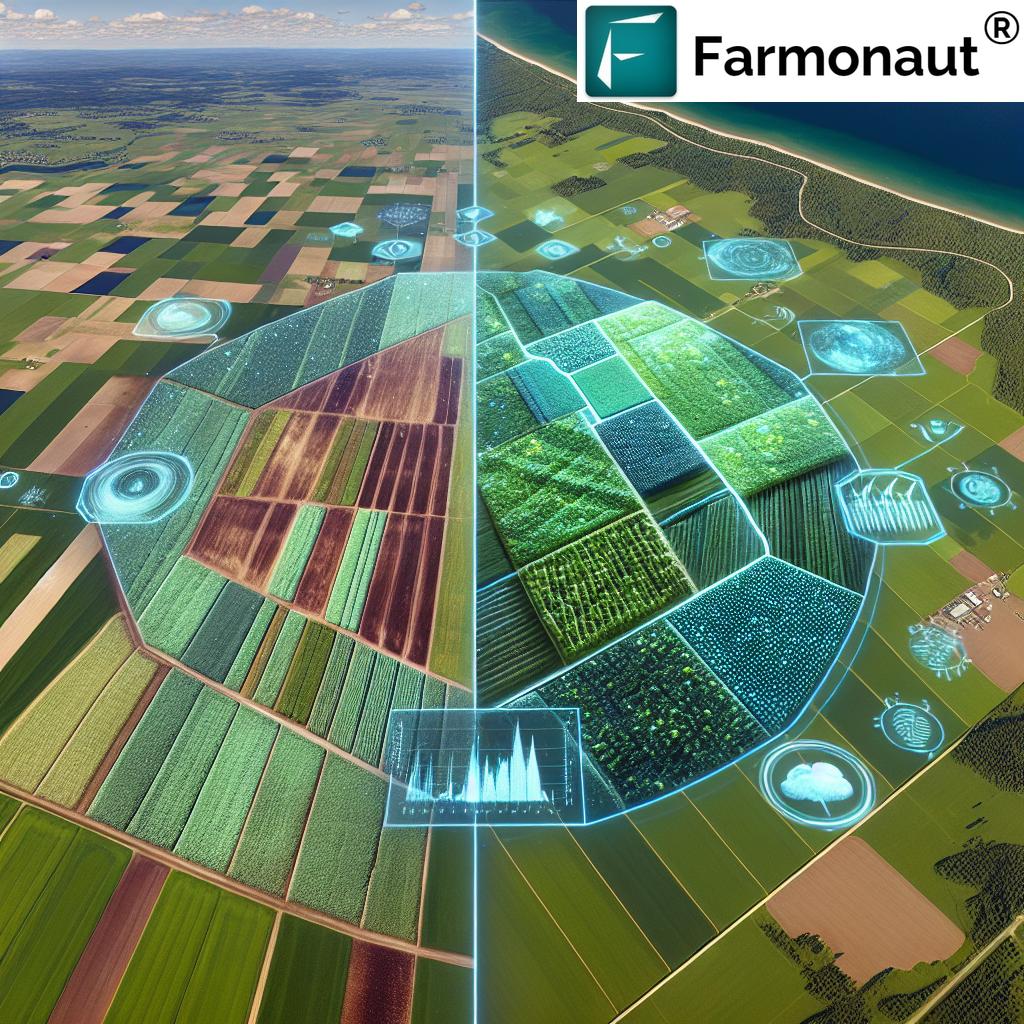Revolutionizing Cheatgrass Management: Spring Grazing Strategies for Sustainable Rangeland Practices in Wyoming
“Targeted spring grazing can reduce cheatgrass seed production by up to 77% in western U.S. rangelands.”
In the vast expanses of the western United States, particularly in states like Wyoming and across the Midwest, a silent battle is being waged against an invasive species that threatens the delicate balance of our rangelands. Cheatgrass, a non-native annual grass, has become a formidable opponent in our quest for sustainable land management. However, recent agricultural research has unveiled a promising weapon in our arsenal: targeted spring grazing strategies.
As we delve into this revolutionary approach to cheatgrass management, we’ll explore how farmers, ranchers, and land managers across the Great Plains and beyond are implementing these methods to not only combat this invasive species but also to enhance livestock production and promote ecological balance.

Understanding the Cheatgrass Challenge
Before we dive into the innovative solutions, it’s crucial to understand the magnitude of the problem we’re facing. Cheatgrass, scientifically known as Bromus tectorum, is an invasive annual grass that has spread rapidly across the western United States. This aggressive species outcompetes native plants, alters fire regimes, and reduces biodiversity in our precious rangelands.
- Rapid spread across western states and territories
- Outcompetes native plant species
- Increases wildfire frequency and intensity
- Reduces forage quality for livestock and wildlife
The traditional approaches to managing cheatgrass have often involved herbicides or mechanical removal, which can be costly, environmentally damaging, and only temporarily effective. This is where our innovative spring grazing strategies come into play, offering a sustainable and potentially more effective solution.
The Power of Targeted Grazing Methods
Recent research conducted in Wyoming has shed light on a game-changing approach to cheatgrass management: targeted spring grazing. This method harnesses the natural behavior of livestock to control the spread and seed production of cheatgrass, while potentially improving animal growth and rangeland health.
Key findings from the study include:
- Up to 77% reduction in cheatgrass seed production
- Optimal grazing window identified in early spring
- Potential improvements in livestock growth rates
- Enhanced native plant diversity and ecosystem health
By implementing these targeted grazing methods, we’re not just managing an invasive species; we’re revolutionizing our approach to sustainable rangeland practices.
Implementing Spring Grazing Strategies
The success of this approach lies in its timing and precision. Let’s break down the key elements of implementing effective spring grazing strategies for cheatgrass management:
- Timing is Everything: The optimal window for grazing cheatgrass is in early spring when the plant is still palatable to livestock and before seed production begins.
- Monitoring Plant Height: Grazing should commence when cheatgrass reaches a height of 4-6 inches and continue until it’s reduced to about 2 inches.
- Livestock Selection: While cattle are commonly used, sheep and goats can also be effective in targeted grazing programs.
- Grazing Intensity: The intensity of grazing should be carefully managed to ensure effective cheatgrass control without damaging desirable native species.
- Rest and Recovery: After grazing, allowing adequate rest periods is crucial for the recovery of native plant communities.
By following these guidelines, farmers and ranchers can effectively implement sustainable rangeland practices that benefit both their operations and the environment.
The Science Behind the Strategy
The effectiveness of spring grazing for cheatgrass management is rooted in the plant’s lifecycle and growth patterns. Cheatgrass is an annual species that completes its lifecycle in a single growing season. By targeting it during its vulnerable early growth stage, we can significantly impact its ability to produce seeds and spread.
Here’s how the science supports this strategy:
- Early spring grazing reduces plant biomass and energy reserves
- Lowered energy reserves limit the plant’s ability to produce seeds
- Repeated grazing can deplete the soil seed bank over time
- Native perennial species, with deeper root systems, are more resilient to grazing pressure
This scientific understanding allows us to develop targeted grazing plans that maximize cheatgrass control while minimizing impact on desirable species.

Benefits Beyond Cheatgrass Control
While the primary goal of these spring grazing strategies is cheatgrass management, the benefits extend far beyond invasive species control in agriculture. Let’s explore some of the additional advantages:
- Improved Livestock Performance: Early spring grazing on cheatgrass can provide nutritious forage for livestock, potentially improving growth rates and overall health.
- Enhanced Biodiversity: By reducing cheatgrass dominance, we create opportunities for native plant species to thrive, increasing overall biodiversity.
- Wildfire Risk Reduction: Cheatgrass is highly flammable and can increase wildfire frequency. Reducing its presence helps mitigate fire risks.
- Soil Health: Proper grazing management can improve soil structure, increase organic matter, and enhance water infiltration.
- Economic Benefits: By integrating grazing into cheatgrass management, ranchers can potentially reduce costs associated with other control methods while improving forage resources.
These multifaceted benefits highlight the potential of spring grazing strategies to transform our approach to rangeland management across the western United States.
“Research in Wyoming reveals an optimal grazing window for effective invasive species control, impacting multiple states.”
Precision Agriculture Techniques in Cheatgrass Management
As we continue to refine our approach to cheatgrass management, the integration of precision agriculture techniques offers exciting possibilities for enhancing the effectiveness of our grazing strategies. This is where innovative companies like Farmonaut come into play, offering cutting-edge solutions for modern agricultural challenges.
Farmonaut’s satellite-based farm management solutions provide valuable tools for implementing and optimizing targeted grazing methods:
- Real-time Vegetation Monitoring: Satellite imagery can help identify areas of cheatgrass infestation and track changes over time.
- AI-driven Insights: Advanced algorithms can analyze data to provide recommendations on optimal grazing times and intensities.
- Resource Management Tools: Efficient allocation of livestock and monitoring of grazing impacts can be facilitated through digital platforms.
By leveraging these technologies, we can enhance the precision and effectiveness of our cheatgrass management strategies, leading to more sustainable and productive rangelands.
Challenges and Considerations
While spring grazing strategies offer promising solutions for cheatgrass management, it’s important to acknowledge the challenges and considerations associated with this approach:
- Weather Variability: Unpredictable spring weather patterns can affect the timing and effectiveness of grazing.
- Livestock Management: Careful planning is required to ensure adequate nutrition and health for grazing animals.
- Monitoring and Adjustment: Continuous monitoring and adaptive management are necessary to optimize results.
- Landscape Variability: Different landscapes may require tailored approaches to grazing management.
- Long-term Commitment: Effective cheatgrass control through grazing requires consistent implementation over multiple years.
Addressing these challenges requires a combination of scientific knowledge, practical experience, and innovative technologies. This is where the integration of precision agriculture tools becomes invaluable in overcoming obstacles and maximizing the benefits of targeted grazing.
Comparing Management Strategies
To better understand the effectiveness of spring grazing strategies compared to other management approaches, let’s examine a comparative analysis:
| Management Strategy | Optimal Grazing Window | Cheatgrass Seed Reduction (%) | Livestock Growth Impact | Environmental Benefits | Cost-Effectiveness |
|---|---|---|---|---|---|
| Traditional Grazing | Variable | 10-30% | Moderate | Low to Moderate | Medium |
| Spring Targeted Grazing | Early Spring | Up to 77% | Potentially High | High | High |
| No Grazing (Control) | N/A | 0% | N/A | Low | Low |
This comparison clearly illustrates the superior results of spring targeted grazing in terms of cheatgrass seed reduction, potential livestock benefits, and overall environmental impact.
Case Studies: Success Stories from the Field
Across the western United States, from the Great Plains to the prairies of Wyoming, farmers and ranchers are implementing spring grazing strategies with impressive results. Here are a few examples of success stories:
- Wyoming Rangeland Restoration: A multi-year study on a 1,000-acre ranch showed a 65% reduction in cheatgrass cover and a 40% increase in native grass species after implementing targeted spring grazing.
- Idaho Grazing Cooperative: A group of ranchers collectively managing 50,000 acres reported a 50% decrease in cheatgrass dominance and improved forage quality for their livestock over a five-year period.
- Colorado Wildfire Prevention: Strategic spring grazing in fire-prone areas led to a 30% reduction in wildfire incidents over three years, demonstrating the broader ecological benefits of this approach.
These case studies highlight the real-world effectiveness of spring grazing strategies in managing cheatgrass and improving overall rangeland health.
The Role of Technology in Optimizing Grazing Strategies
As we continue to refine our approach to cheatgrass management through spring grazing, the integration of advanced technologies becomes increasingly important. Farmonaut’s precision agriculture solutions offer valuable tools for optimizing these strategies:
- Satellite-Based Crop Monitoring: Real-time vegetation health data can help identify optimal grazing areas and track the progress of cheatgrass control efforts.
- AI-Powered Advisory Systems: Advanced algorithms can analyze multiple data points to provide recommendations on grazing timing and intensity.
- Blockchain-Based Traceability: Ensuring the authenticity and transparency of sustainable grazing practices can add value to livestock products.
- Resource Management Tools: Efficient allocation of livestock and monitoring of grazing impacts can be facilitated through digital platforms.
By leveraging these technologies, ranchers and land managers can enhance the precision and effectiveness of their cheatgrass management strategies, leading to more sustainable and productive rangelands.
Explore Farmonaut’s API Solutions
Future Directions and Research
As we look to the future of cheatgrass management and sustainable rangeland practices, several exciting avenues for research and development emerge:
- Precision Grazing Technologies: Development of GPS-enabled livestock collars and virtual fencing systems to enhance grazing precision.
- Genetic Research: Exploring the potential for developing more palatable cheatgrass varieties that could enhance the effectiveness of grazing control.
- Ecosystem Modeling: Advanced computer models to predict long-term impacts of grazing strategies on rangeland ecosystems.
- Climate Change Adaptation: Investigating how changing climate patterns may affect cheatgrass growth and grazing strategies.
- Integrated Management Approaches: Exploring synergies between grazing and other control methods for comprehensive cheatgrass management.
These research directions hold promise for further refining and enhancing our approach to cheatgrass management, ensuring the long-term health and productivity of our rangelands.
Conclusion: A Sustainable Path Forward
As we’ve explored throughout this article, the implementation of spring grazing strategies for cheatgrass management represents a significant leap forward in our approach to sustainable rangeland practices. By harnessing the natural grazing behavior of livestock and timing our interventions precisely, we can effectively control this invasive species while promoting healthier ecosystems and more productive agricultural operations.
The benefits of this approach extend far beyond mere weed control. From improved livestock performance to enhanced biodiversity and reduced wildfire risk, the positive impacts ripple through entire ecosystems and agricultural communities. As we continue to refine these methods and integrate cutting-edge technologies, the potential for widespread adoption and success grows ever greater.
For farmers, ranchers, and land managers across the western United States, from the Great Plains to the prairies of Wyoming, these strategies offer a path towards more sustainable, resilient, and productive rangelands. By embracing these innovative approaches and leveraging the power of precision agriculture, we can work towards a future where our rangelands thrive, our agricultural operations prosper, and our ecosystems flourish.
As we move forward, let us continue to invest in research, embrace new technologies, and share knowledge across our agricultural communities. Together, we can revolutionize cheatgrass management and pave the way for a more sustainable and productive future for our rangelands.
Explore Farmonaut’s API Developer Docs
Frequently Asked Questions (FAQ)
Q: What is cheatgrass and why is it a problem?
A: Cheatgrass is an invasive annual grass that outcompetes native plants, alters fire regimes, and reduces biodiversity in rangelands across the western United States.
Q: How effective is spring grazing for cheatgrass control?
A: Research shows that targeted spring grazing can reduce cheatgrass seed production by up to 77%, making it a highly effective control method.
Q: When is the optimal time for spring grazing to control cheatgrass?
A: The optimal window is in early spring when cheatgrass reaches a height of 4-6 inches and before seed production begins.
Q: Can spring grazing strategies benefit livestock performance?
A: Yes, early spring grazing on cheatgrass can provide nutritious forage for livestock, potentially improving growth rates and overall health.
Q: How do precision agriculture techniques help in cheatgrass management?
A: Precision agriculture tools, such as satellite monitoring and AI-driven insights, can help optimize grazing timing, intensity, and location for more effective cheatgrass control.
Q: Are there any environmental benefits to using grazing for cheatgrass control?
A: Yes, effective grazing can reduce wildfire risk, improve biodiversity, and enhance overall ecosystem health in rangelands.
Q: How long does it take to see results from spring grazing strategies?
A: While some benefits may be observed in the first year, consistent implementation over multiple years is typically required for significant, long-term cheatgrass control.




















